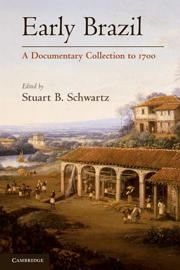Book contents
- Frontmatter
- Contents
- Preface
- A Note on Translation
- A Note on Portuguese Currency, Weights, and Measures
- Maps
- 1 The “Discovery” and First Encounters with Brazil
- 2 The Donatarial System
- 3 Royal Government
- 4 The French Interlude
- 5 Indians, Jesuits, and Colonists
- 6 The World of the Engenhos
- 7 Government and Society in Dutch Brazil
- 8 Burdens of Slavery and Race
- 9 Public and Private Power
- 10 Religion and Society
- 11 Frontiers
- Index
1 - The “Discovery” and First Encounters with Brazil
Published online by Cambridge University Press: 05 June 2012
- Frontmatter
- Contents
- Preface
- A Note on Translation
- A Note on Portuguese Currency, Weights, and Measures
- Maps
- 1 The “Discovery” and First Encounters with Brazil
- 2 The Donatarial System
- 3 Royal Government
- 4 The French Interlude
- 5 Indians, Jesuits, and Colonists
- 6 The World of the Engenhos
- 7 Government and Society in Dutch Brazil
- 8 Burdens of Slavery and Race
- 9 Public and Private Power
- 10 Religion and Society
- 11 Frontiers
- Index
Summary
The Letter of Pero Vaz de Caminha
Following the return to Portugal of Vasco da Gama in 1499 after his successful voyage to India around the Cape of Good Hope, a second fleet of thirteen ships set sail from Lisbon in March 1500, commanded by Pedro Alvares Cabral, to follow the same route. In late April of that year, it made a landfall on the Brazilian coast. After briefly exploring the coast and establishing some contact with the native peoples, the main fleet continued on its way to India, but a small ship was detached to return to Portugal. It carried two letters with details on the new land and its people. The letter of Pero Vaz de Caminha is often described as the foundational document of Brazilian history. Vaz de Caminha, of a noble family from Oporto, was most likely traveling to India to take up a post as the secretary at the trading post to be established there, but he was also serving as scribe for the fleet. In many ways, his report paralleled the first letters of Columbus from the Caribbean, providing details about the geography, peoples, and conditions in the new lands. The letter of Pero Vaz de Caminha disappeared from sight until the late eighteenth century, when it was uncovered in the Portuguese royal archive. It was first published in 1817 (Aires de Casal, Corografia Brasilica [Rio de Janeiro, 1817]) and subsequently has been published in innumerable editions.
(The excerpted translation presented here is from Charles David Ley, ed., Portuguese Voyages, 1498–1663, Everyman's Library, No. 986 (New York: Dutton & Co., pp. 42–45, 53–54, 56–59.)This same day, at the hour of vespers we sighted land, that is to say, first a very high rounded mountain, then other lower ranges of hills to the south of it, and a plain covered with large trees. The admiral named the mountain Easter Mount and the country the Land of the True Cross.
- Type
- Chapter
- Information
- Early BrazilA Documentary Collection to 1700, pp. 1 - 12Publisher: Cambridge University PressPrint publication year: 2009



